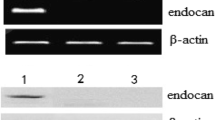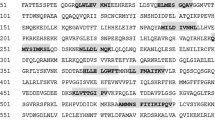Abstract
CD4 T cells are important for anti-tumor immune responses. Aside from their role in the activation of CD8 T cells, CD4 T cells also mediate anti-tumor immune responses by recruiting innate immune effectors into the tumor microenvironment. Thus, the search for strategies to boost CD4 T cell immunity is an active area of research. Our goal in this study was to identify HLA-DR epitopes of carcinoembryonic antigen (CEA), a commonly over-expressed tumor antigen. HLA-DR epitopes of CEA were identified using the epitope prediction program, PIC (predicted IC50) and tested using in vitro HLA-DR binding assays. Following CEA epitope confirmation, IFN-γ ELIspot assays were used to detect existing immunity against the HLA-DR epitope panel of CEA in breast and ovarian cancer patients. In vitro generated peptide-specific CD4 T cells were used to determine whether the epitopes are naturally processed from CEA protein. Forty-three epitopes of CEA were predicted, 15 of which had high binding affinity for 8 or more common HLA-DR molecules. A degenerate pool of four, HLA-DR restricted 15 amino acid epitopes (CEA.24, CEA.176/354, CEA.488, and CEA.653) consisting of two novel epitopes (CEA.24 and CEA.488) was identified against which 40% of breast and ovarian cancer patients had pre-existent T cell immunity. All four epitopes are naturally processed by antigen-presenting cells. Hardy–Weinberg analysis showed that the pool is useful in ~94% of patients. Patients with breast or ovarian cancer demonstrate pre-existent immune responses to the tumor antigen CEA. The degenerate pool of CEA peptides may be useful for augmenting CD4 T cell immunity.




Similar content being viewed by others
References
Yee C, Thompson JA, Byrd D, Riddell SR, Roche P, Celis E, Greenberg PD (2002) Adoptive T cell therapy using antigen-specific CD8+ T cell clones for the treatment of patients with metastatic melanoma: in vivo persistence, migration, and antitumor effect of transferred T cells. Proc Natl Acad Sci USA 99:16168–16173
Knutson KL, Disis ML (2005) Tumor antigen-specific T helper cells in cancer immunity and immunotherapy. Cancer Immunol Immunother 54:721–728
Kobayashi H, Omiya R, Ruiz M, Huarte E, Sarobe P, Lasarte JJ, Herraiz M, Sangro B, Prieto J, Borras-Cuesta F, Celis E (2002) Identification of an antigenic epitope for helper T lymphocytes from carcinoembryonic antigen. Clin Cancer Res 8:3219–3225
Campi G, Crosti M, Consogno G, Facchinetti V, Conti-Fine BM, Longhi R, Casorati G, Dellabona P, Protti MP (2003) CD4(+) T cells from healthy subjects and colon cancer patients recognize a carcinoembryonic antigen-specific immunodominant epitope. Cancer Res 63:8481–8486
Kalli KR, Krco CJ, Hartmann LC, Goodman K, Maurer MJ, Yu C, Johnson EM, Erskine CL, Disis ML, Wettstein PJ, Fikes JD, Beebe M, Ishioka G, Knutson KL (2008) An HLA-DR-degenerate epitope pool detects insulin-like growth factor binding protein 2-specific immunity in patients with cancer. Cancer Res 68:4893–4901
Knutson KL, Krco CJ, Erskine CL, Goodman K, Kelemen LE, Wettstein PJ, Low PS, Hartmann LC, Kalli KR (2006) T-cell immunity to the folate receptor alpha is prevalent in women with breast or ovarian cancer. J Clin Oncol 24:4254–4261
Fujita H, Senju S, Yokomizo H, Saya H, Ogawa M, Matsushita S, Nishimura Y (1998) Evidence that HLA class II-restricted human CD4+ T cells specific to p53 self peptides respond to p53 proteins of both wild and mutant forms. Eur J Immunol 28:305–316
Kobayashi H, Wood M, Song Y, Appella E, Celis E (2000) Defining promiscuous MHC class II helper T-cell epitopes for the HER2/neu tumor antigen. Cancer Res 60:5228–5236
Kobayashi H, Lu J, Celis E (2001) Identification of helper T-cell epitopes that encompass or lie proximal to cytotoxic T-cell epitopes in the gp100 melanoma tumor antigen. Cancer Res 61:7577–7584
Jager E, Jager D, Karbach J, Chen YT, Ritter G, Nagata Y, Gnjatic S, Stockert E, Arand M, Old LJ, Knuth A (2000) Identification of NY-ESO-1 epitopes presented by human histocompatibility antigen (HLA)-DRB4*0101–0103 and recognized by CD4(+) T lymphocytes of patients with NY-ESO-1-expressing melanoma. J Exp Med 191:625–630
Zarour HM, Kirkwood JM, Kierstead LS, Herr W, Brusic V, Slingluff CL Jr, Sidney J, Sette A, Storkus WJ (2000) Melan-A/MART-1(51–73) represents an immunogenic HLA-DR4-restricted epitope recognized by melanoma-reactive CD4(+) T cells. Proc Natl Acad Sci USA 97:400–405
Topalian SL, Gonzales MI, Parkhurst M, Li YF, Southwood S, Sette A, Rosenberg SA, Robbins PF (1996) Melanoma-specific CD4+ T cells recognize nonmutated HLA-DR-restricted tyrosinase epitopes. J Exp Med 183:1965–1971
Kass ES, Greiner JW, Kantor JA, Tsang KY, Guadagni F, Chen Z, Clark B, De Pascalis R, Schlom J, Van Waes C (2002) Carcinoembryonic antigen as a target for specific antitumor immunotherapy of head and neck cancer. Cancer Res 62:5049–5057
Hodge JW, Tsang KY, Poole DJ, Schlom J (2003) General keynote: vaccine strategies for the therapy of ovarian cancer. Gynecol Oncol 88:S97–S104, discussion S110–S113
Guadagni F, Roselli M, Cosimelli M, Spila A, Cavaliere F, Arcuri R, D’Alessandro R, Fracasso PL, Casale V, Vecchione A, Casciani CU, Greiner JW, Schlom J (1997) Quantitative analysis of CEA expression in colorectal adenocarcinoma and serum: lack of correlation. Int J Cancer 72:949–954
Ordonez C, Screaton RA, Ilantzis C, Stanners CP (2000) Human carcinoembryonic antigen functions as a general inhibitor of anoikis. Cancer Res 60:3419–3424
Screaton RA, Penn LZ, Stanners CP (1997) Carcinoembryonic antigen, a human tumor marker, cooperates with Myc and Bcl-2 in cellular transformation. J Cell Biol 137:939–952
Kawashima I, Tsai V, Southwood S, Takesako K, Sette A, Celis E (1999) Identification of HLA-A3-restricted cytotoxic T lymphocyte epitopes from carcinoembryonic antigen and HER-2/neu by primary in vitro immunization with peptide-pulsed dendritic cells. Cancer Res 59:431–435
Zaremba S, Barzaga E, Zhu M, Soares N, Tsang KY, Schlom J (1997) Identification of an enhancer agonist cytotoxic T lymphocyte peptide from human carcinoembryonic antigen. Cancer Res 57:4570–4577
Kawashima I, Hudson SJ, Tsai V, Southwood S, Takesako K, Appella E, Sette A, Celis E (1998) The multi-epitope approach for immunotherapy for cancer: identification of several CTL epitopes from various tumor-associated antigens expressed on solid epithelial tumors. Hum Immunol 59:1–14
Marshall JL, Gulley JL, Arlen PM, Beetham PK, Tsang KY, Slack R, Hodge JW, Doren S, Grosenbach DW, Hwang J, Fox E, Odogwu L, Park S, Panicali D, Schlom J (2005) Phase I study of sequential vaccinations with fowlpox-CEA(6D)-TRICOM alone and sequentially with vaccinia-CEA(6D)-TRICOM, with and without granulocyte-macrophage colony-stimulating factor, in patients with carcinoembryonic antigen-expressing carcinomas. J Clin Oncol 23:720–731
Bos R, van Duikeren S, van Hall T, Kaaijk P, Taubert R, Kyewski B, Klein L, Melief CJ, Offringa R (2005) Expression of a natural tumor antigen by thymic epithelial cells impairs the tumor-protective CD4+ T-cell repertoire. Cancer Res 65:6443–6449
Sette A, Buus S, Appella E, Smith JA, Chesnut R, Miles C, Colon SM, Grey HM (1989) Prediction of major histocompatibility complex binding regions of protein antigens by sequence pattern analysis. Proc Natl Acad Sci USA 86:3296–3300
Sette A, Buus S, Colon S, Miles C, Grey HM (1989) Structural analysis of peptides capable of binding to more than one Ia antigen. J Immunol 142:35–40
Knutson KL, Schiffman K, Disis ML (2001) Immunization with a HER-2/neu helper peptide vaccine generates HER-2/neu CD8 T-cell immunity in cancer patients. J Clin Invest 107:477–484
Southwood S, Sidney J, Kondo A, del Guercio MF, Appella E, Hoffman S, Kubo RT, Chesnut RW, Grey HM, Sette A (1998) Several common HLA-DR types share largely overlapping peptide binding repertoires. J Immunol 160:3363–3373
Sidney J, Southwood S, Oseroff C, del Guercio MF, Sette A, Grey HM (2001) Measurement of MHC/peptide interactions by gel filtration. Curr Protoc Immunol 18:18.3
Marsh GE, Parham P, Barber LD (2000) The HLA facts book. Academic Press, San Diego
Wilson CC, Palmer B, Southwood S, Sidney J, Higashimoto Y, Appella E, Chesnut R, Sette A, Livingston BD (2001) Identification and antigenicity of broadly cross-reactive and conserved human immunodeficiency virus type 1-derived helper T-lymphocyte epitopes. J Virol 75:4195–4207
Hammarstrom S (1999) The carcinoembryonic antigen (CEA) family: structures, suggested functions and expression in normal and malignant tissues. Semin Cancer Biol 9:67–81
Hogdall EV, Christensen L, Kjaer SK, Blaakaer J, Jarle Christensen I, Gayther S, Jacobs IJ, Hogdall CK (2008) Protein expression levels of carcinoembryonic antigen (CEA) in Danish ovarian cancer patients: from the Danish ‘MALOVA’ ovarian cancer study. Pathology 40:487–492
Kobayashi H, Celis E (2008) Peptide epitope identification for tumor-reactive CD4 T cells. Curr Opin Immunol 20:221–227
Disis ML, Knutson KL, Schiffman K, Rinn K, McNeel DG (2000) Pre-existent immunity to the HER-2/neu oncogenic protein in patients with HER-2/neu overexpressing breast and ovarian cancer. Breast Cancer Res Treat 62:245–252
Disis ML, Gooley TA, Rinn K, Davis D, Piepkorn M, Cheever MA, Knutson KL, Schiffman K (2002) Generation of T-cell immunity to the HER-2/neu protein after active immunization with HER-2/neu peptide-based vaccines. J Clin Oncol 20:2624–2632
Knutson KL, Schiffman K, Cheever MA, Disis ML (2002) Immunization of cancer patients with a HER-2/neu, HLA-A2 peptide, p369–377, results in short-lived peptide-specific immunity. Clin Cancer Res 8:1014–1018
Morse MA, Deng Y, Coleman D, Hull S, Kitrell-Fisher E, Nair S, Schlom J, Ryback ME, Lyerly HK (1999) A Phase I study of active immunotherapy with carcinoembryonic antigen peptide (CAP-1)-pulsed, autologous human cultured dendritic cells in patients with metastatic malignancies expressing carcinoembryonic antigen. Clin Cancer Res 5:1331–1338
Weihrauch MR, Ansen S, Jurkiewicz E, Geisen C, Xia Z, Anderson KS, Gracien E, Schmidt M, Wittig B, Diehl V, Wolf J, Bohlen H, Nadler LM (2005) Phase I/II combined chemoimmunotherapy with carcinoembryonic antigen-derived HLA-A2-restricted CAP-1 peptide and irinotecan, 5-fluorouracil, and leucovorin in patients with primary metastatic colorectal cancer. Clin Cancer Res 11:5993–6001
Saha A, Chatterjee SK, Foon KA, Celis E, Bhattacharya-Chatterjee M (2007) Therapy of established tumors in a novel murine model transgenic for human carcinoembryonic antigen and HLA-A2 with a combination of anti-idiotype vaccine and CTL peptides of carcinoembryonic antigen. Cancer Res 67:2881–2892
Shen L, Schroers R, Hammer J, Huang XF, Chen SY (2004) Identification of a MHC class-II restricted epitope in carcinoembryonic antigen. Cancer Immunol Immunother 53:391–403
Tassi E, Gavazzi F, Albarello L, Senyukov V, Longhi R, Dellabona P, Doglioni C, Braga M, Di Carlo V, Protti MP (2008) Carcinoembryonic antigen-specific but not antiviral CD4+ T cell immunity is impaired in pancreatic carcinoma patients. J Immunol 181:6595–6603
Ruiz M, Kobayashi H, Lasarte JJ, Prieto J, Borras-Cuesta F, Celis E, Sarobe P (2004) Identification and characterization of a T-helper peptide from carcinoembryonic antigen. Clin Cancer Res 10:2860–2867
Haidopoulos D, Konstadoulakis MM, Antonakis PT, Alexiou DG, Manouras AM, Katsaragakis SM, Androulakis GF (2000) Circulating anti-CEA antibodies in the sera of patients with breast cancer. Eur J Surg Oncol 26:742–746
Knutson KL, Almand B, Dang Y, Disis ML (2004) Neu antigen-negative variants can be generated after neu-specific antibody therapy in neu transgenic mice. Cancer Res 64:1146–1151
Acknowledgments
The authors gratefully acknowledge the Mayo Clinic Comprehensive Cancer Center Immune Monitoring Core for performing the ELIspot assays, the Mayo Clinic Proteomics Research Center and Tissue and Cell Molecular Analysis Center (TACMA). The assistance of Corazon dela Rosa and Jennifer Childs is greatly appreciated. This work was supported by the Mayo Clinic Comprehensive Cancer Center, generous gifts from Martha and Bruce Atwater (KLK), K01-CA100764 (KLK), P50-CA116201 (JI), K12-CA090628 (KRK, LH), and R41-CA107590-01 (GI, KLK, JF).
Author information
Authors and Affiliations
Corresponding author
Additional information
L. Karyampudi and C. J. Krco are co-first authors. G. Ishioka and K. L. Knutson are co-senior authors.
Rights and permissions
About this article
Cite this article
Karyampudi, L., Krco, C.J., Kalli, K.R. et al. Identification of a broad coverage HLA-DR degenerate epitope pool derived from carcinoembryonic antigen. Cancer Immunol Immunother 59, 161–171 (2010). https://doi.org/10.1007/s00262-009-0738-z
Received:
Accepted:
Published:
Issue Date:
DOI: https://doi.org/10.1007/s00262-009-0738-z




